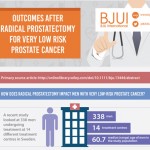Randomised Controlled Trials in Robotic Surgery
It has been nearly 15 years since one of the first ever randomised controlled trials (RCT) in robotic surgery was conducted in 2002. The STAR-TRAK compared telerobotic percutaneous nephrolithotomy (PCNL) to standard PCNL and showed that the robot was slower but more accurate than the human hand [1].
In the 24 h since the much anticipated RCT of open vs robot-assisted radical prostatectomy was published in The Lancet [2], our BJUI blog from @declangmurphy was viewed >2500 times, receiving >40 comments, making it one of our most read and interactive blogs ever. It is a negative trial showing no differences in early functional outcomes between the two approaches.
And it is not the only negative trial of its kind as a number of others have matured and reported recently. The RCT of open vs robot-assisted radical cystectomy and extracorporeal urinary diversion showed no differences in the two arms [3], and likewise a comparison of the two approaches to cystectomy as a prelude to the RAZOR (randomised open vs robotic cystectomy) trial showed no differences in quality of life at 3-monthly time points up to a year [4]. The only RCT comparing open, laparoscopic and robotic cystectomy, the CORAL, took a long time to recruit and yet again showed no differences in 90-day complication rates between the three techniques [5].
In all likelihood, despite the level 1 evidence provided in The Lancet paper showing no superiority of the robotic over the open approach, the Brisbane study may not change the current dominance of robotic prostatectomy in those countries who can afford this technology. Why is this? Apart from the inherent limitations that the BJUI blog identifies, there are other factors to consider. In particular, as observed previously in a memorable article ‘Why don’t Mercedes Benz publish randomised trials?’ [6], there may be reasons why surgical technique is not always suited to the RCT format.
A few additional reflections are perhaps appropriate at this time:
- Despite the best statistical input many of these and future studies are perhaps underpowered.
- Many have argued that the RCTs have shown robotics to be as good, although not better than open surgery, even in the hands of less experienced surgeons.
- Patient reported quality of life should perhaps become the primary outcome measure because that in the end that is what truly matters.
- Cost-effectiveness ratios should feature prominently, as otherwise there is much speculation by the lay press without any hard data.
- Industry has a role to play here in keeping costs manageable, so that these ratios can become more palatable to payers.
- Surgery is more of an art than a science. The best surgeons armed with the best technology that they are comfortable with will achieve the best outcomes for their patients.
While this debate will continue and influence national healthcare providers and decision makers, the message looks much clearer when it comes to training the next generation of robotic surgeons. A cognitive- and performance-based RCT using a device to simulate vesico-urethral anastomosis after robot-assisted radical prostatectomy (RARP) showed a clear advantage in favour of such structured training [7]. In this months’ issue of the BJUI, we present the first predictive validity of robotic simulation showing better clinical performance of RARP in patients [8]. This is a major step forward in patient safety and would reassure policy makers that investment in simulation of robotic technology rather than the traditional unstructured training is the way forward.
Most of our patients are knowledgeable, extensively research their options on ‘Dr Google’ and decide what is good for them. It is for this reason that many did not agree to randomisation in other robotic vs open surgery RCTs, like LopeRA (RCT of laparoscopic, open and robot assisted prostatectomy as treatment for organ-confined prostate cancer) and BOLERO (Bladder cancer: Open vs Lapararoscopic or RObotic cystectomy). Many of them continue to choose robotic surgery without necessarily paying heed to the best scientific evidence. Perhaps what patients will now do is select an experienced surgeon whom they can trust to use their best technology to deliver the best clinical outcomes.
@declangmurphy
Associate Editor BJUI
References
4
Messer JC, Punnen S , Fitzgerald J et al. Health-related quality of life from a
5
Khan MS, Gan C, Ahmed K et al. A single-centre early phase randomised controlled three-arm trial of open, robotic, and laparoscopic radical cystectomy (CORAL). Eur Urol 2016; 69: 613–21



